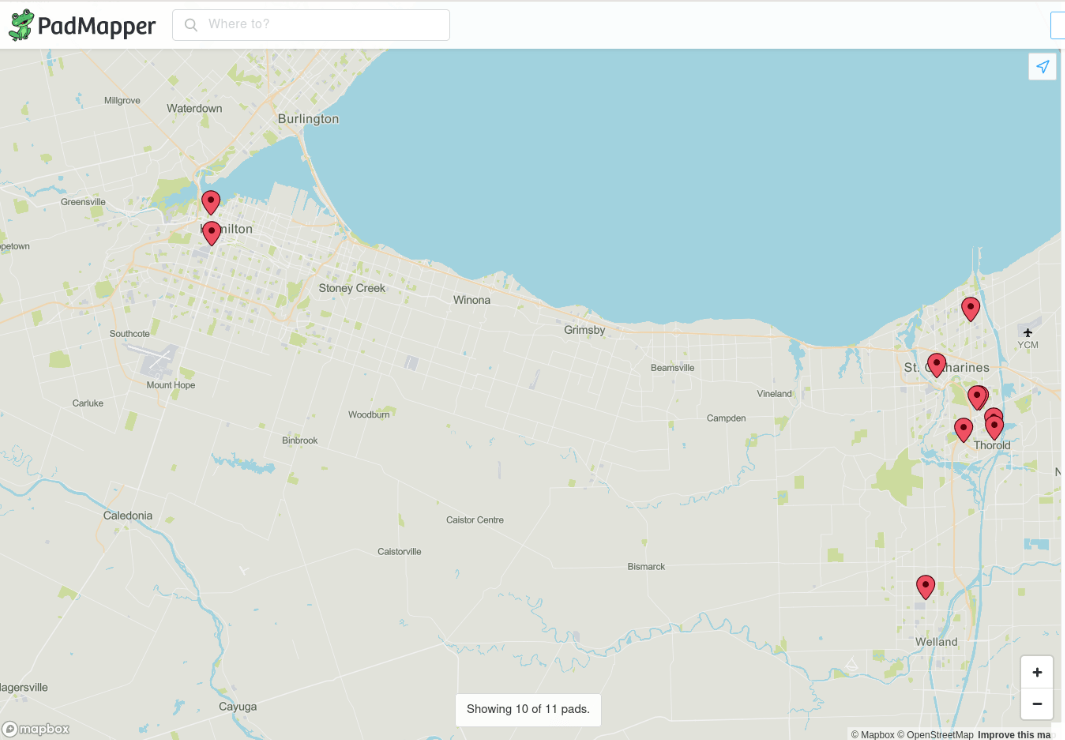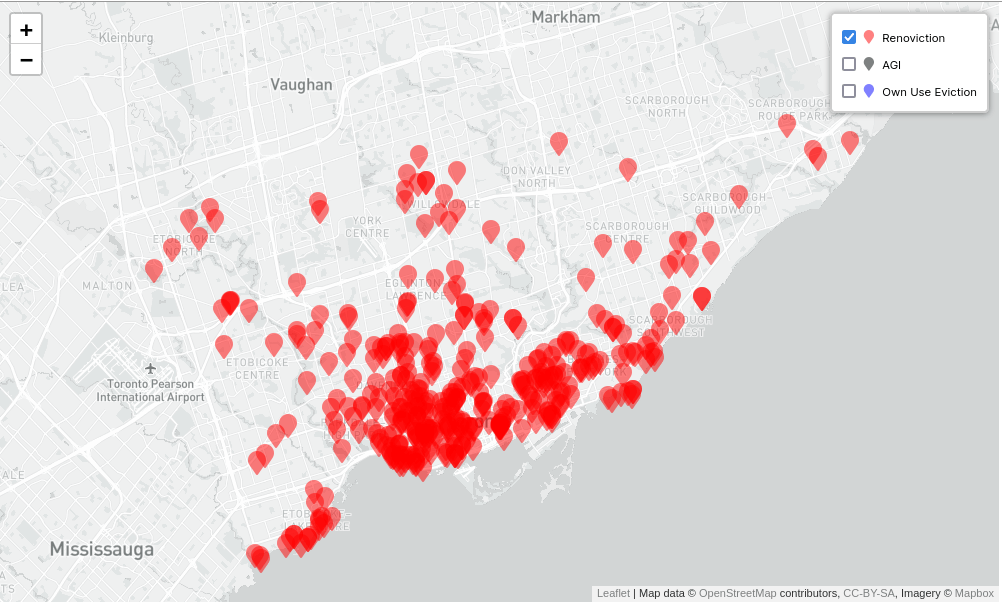The Point: Renoviction and the invisible eviction crisis
Posted March 4, 2022
Posted March 4, 2022
Ontario has a big problem with evictions. How big? No one knows for sure.
While the Landlord and Tenant Board (LTB) is ramping up the assembly-line to pump out evictions, there is no means to measure the depth of the crisis. No government or agency is keeping count. An eviction crisis is occurring behind a curtain of statistical invisibility.
Mark, a young entrepreneur in Hamilton’s hospitality industry, personifies the ambitious city. He’s not rich, but he has been successfully operating his own business since 2018 and he has remained open throughout the pandemic. Because his business serves guests, he prefers to use only his first name.
The pandemic and ensuing lockdowns have been a struggle for Mark, eroding about 80 per cent of his business revenues. That loss of income was challenging enough, but then Hamilton’s housing crisis delivered him another shock when he was served with a notice to vacate his apartment.
For the past four years, he has resided in the Stipley neighbourhood within a small 12 unit, three floor, red brick apartment building. He pays $835 per month for a one bedroom plus a den. Last year, his building was transferred to new owners, and this year, Mark is being ordered to leave so the unit can renovated — he is being renovicted.
A “renoviction” is slang for the practice of landlords evicting tenants to make renovations. Tenants and tenant advocates use the term derisively to describe landlords employing a legal loophole to evict long-term tenants and increase rents.
“The goal of renovictions is for landlords to force out existing tenants under the guise of renovating or repairing a rental unit or building, so that the landlord can increase rents and maximize profit,” is the way ACORN, a tenants’ advocacy group describes it.
Mark has looked for another apartment but there’s nothing available at the rent he currently pays in his neighbourhood or within a reasonable distance of his business. For Mark, staying in Hamilton likely means a significant increase to his cost of living, despite the loss of income resulting directly from mandated lockdowns.


PadMapper.com displays rental units available for up to $1450 per month. The median rent in Hamilton for a one bedroom apartment is currently $1,486 according to zumper.com.
Renovictions are not at all unique to Hamilton. Premier Doug Ford introduced amendments to Ontario rental laws that removed from rent control units that are new or are “extensively renovated.” The Toronto Star reported on tenants facing hefty rent hikes:
“Her landlord has suggested increasing the … [rent] … to between $2,350 and $2,650 this spring — a jump of between 20.5 and 35.9 per cent … That would be allowed under a three-year-old exemption to Ontario’s rent control rules, for units first occupied after Nov. 15, 2018, introduced by Doug Ford’s Progressive Conservatives not long after forming government”.
Compare this legal rent increase of “between 20.5 and 35.9 per cent” with the 1.2 per cent approved by the Ontario government for rent controlled units as reported by Global News. Because the new regulation applies to both new and renovated units, landlords have a financial incentive to renovate existing properties, and it all begins with the form N13 should there be tenants with controlled rent.
The law requires the landlord to allow the tenant to return to the unit at the same rent, provided the tenant notified the landlord their intention to return, in writing, before moving out. The tenant must provide a mailing address and keep the landlord updated on any address changes, again, in writing.
In 2019, the Hamilton Spectator reported on a man, John McDonagh, who lost his home of 40 years even though he believes he followed the rules. The landlord said they were unable to reach him: “We tried to get a hold of him a few times. I sent him a couple of letters.”
Renovations can take as long or longer than a year and even with the best intentions, wires can get crossed. Did John McDonagh go to the LTB? In researching for this report, no records were found.
Housing policy is seemingly developed in a data vacuum. The City of Hamilton can’t know how many newly houseless people there will be over the next 120 days for planning purposes because it’s impossible to know how many eviction notices are entering the pipeline.
“Unfortunately I can’t give you a number because we don’t have a number. We don’t have the data to be able to say there is a 60 per cent increase or 100 per cent increase or anything like that,” said Magda Barrera, housing and economics policy analyst with Legal Aid Ontario, when asked how many more renoviction orders, or N13s, are being issued in Ontario.
The housing and affordability crises were already brewing before Doug Ford was elected, but the changes he made to the Residential Tenancies Act (RTA) have made matters much worse. Before, Hamilton’s housing crisis was largely driven by GTA-ers looking for homes they could afford; now it’s additionally inflamed by investors looking to cash in on uncontrolled market rents that are detached from incomes.
“According to a recent analysis by Teranet, the province’s online land registration provider, people who already own at least one property made up 25 per cent of home buyers last year,” reported CBC News, warning investors are pushing home prices higher.

Multi-Property owners now represent more than 1/4 of all residential property sales in Ontario, according to Teranet.
Astonishingly, nothing is tracked. In the age of the database, eviction notices are done on paper and not through any provincial or municipal computer system. Renovations must be “extensive enough to require a building permit,” but in 2022, when smartphones can track an Amazon shipment from China, there is no means to link building permits to the N13 notice or vice-versa.
According to Barrera, at the LTB “… there is a push toward digitalization and I really wish that that push included data access and comprehensive databases. “
The only means of measuring the state of the rental housing crisis in Ontario is through the legal lens of the LTB, which represents only some of what’s fully taking place in the market. The LTB data “tells us the number of hearings, per group,” explained Barrera, “so it’s not exactly the total number of outstanding eviction notices.”
That may change to some extent in Hamilton as the city reviews what’s known as the New Westminster by-law.
New Westminster is a city within the regional area of Vancouver that in 2019 adopted a by-law to combat renovictions described to the CBC as a “crisis”.
“The New Westminster by-law, as I understand it, is setting limits to the use of renovictions,” explained Barrera. “So it gives authority to the municipality and they can basically stop renovictions from taking place.”
The New Westminster by-law requires landlords to provide tenants with temporary accommodation during a renovation and to allow those tenants to return to the renovated unit on the same terms as prior to renovation. The by-law was upheld in court following a legal challenge.
“According to (New Westminster) city statistics, renovictions went from a combined 333 households between 2016 and 2018 to zero since 2019, when the bylaw came into force,” reported Acorn Canada.
This past December, Hamilton’s Emergency and Community Service’s Committee approved hiring a consultant to adapt the New Westminster by-law for Hamilton.
Ward 3 Councillor Nrinder Nann sits on the committee and she says a New Westminster-type by-law in Hamilton would “… enable the city to track landlords seeking to engage in renovations and ensure they are conducting their business in accordance to the bylaw and not displacing residents.” She added, “In New Westminster, the amendment was successful and resulted in a significant decrease in the number of reported renovictions and inquiries of concern.”
To be ratified at Council, as of ECS Cmttee today, #HamOnt is officially developing the path to anti-renovictions bylaw regime. This is the result of tenant organizing & @AcornHamilton advocacy. It is part of a suite of initiatives to secure safe, dignified & affordable housing!
— Nrinder Nann (@NrinderWard3) December 10, 2021
According to Councillor Nann, “Currently as a city we don’t know when a developer or a landlord is renovating their units unless they go through the formal zoning process.” She said a new by-law would address “… cases where people are just taking an existing multi-unit home or building and doing surface level improvements … the kind of low-grade renovations that we do see happening, and then turn around and hike up the rent.”
In terms of a timeline, Councillor Nann expects a consultant to be selected between April and May of this year with the potential of a staff report being ready for council to consider by autumn, in time for a municipal election.

RenovictionsTO crowd sources a map of renovictions in Toronto.
Councillor Nann, in shining some light on the extent of the crisis, indicated that, “According to City of Toronto data, 30 per cent of those whom are now homeless are so as a result of renovictions.” In Hamilton, she said, “Every week I’m writing five to seven letters to landlords trying to compel them not to not end tenancy. Most of the cases are situations of renoviction.”
For Mark and others like him, the proposed solution won’t offer any relief now. The various groups supporting tenants in Hamilton and Ontario will all advise him to demand his hearing before the LTB. If he does take that route, we as a city likely won’t know about it nor the outcome, or where he ends up living. He will be behind the curtain of statistical invisibility.
***
Article by Sean Hurley for The Point


